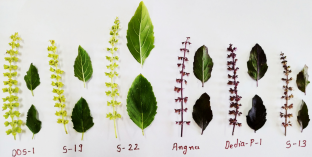Field marker character for essential oil content in green herbage through leaf colour intensity in holy basil (Ocimum sanctum L.)
Research Articles | Published: 28 June, 2021
First Page: 889
Last Page: 897
Views: 3824
Keywords: Ocimum sanctum , Peltate glands, Essential oil yield, Leaf color intensity, Marker character
Abstract
Six accessions of holy basil (Rama and Shyama) obtained from different parts of India were evaluated for morphological and quantitative parameters. These accessions were observed for leaf colour, trichome type, number and size of peltate gland (PG), stem girth, branches and other agronomical parameters. Besides that, they were also observed for yield contributing characters viz., maximum plant height, spread, stem girth, fresh leaf, dry leaf, herbage yield and essential oil yield. DOS-22 was found superior for larger leaf, herbage and essential oil yield. Maximum number of peltate glands (PG) on abaxial leaf surface as compared to adaxial were recorded. However, PGs formation takes place only in younger leaves, therefore, the numbers of PGs were reduced due to expansion of leaf area with progression of age. Purple leaf colour intensity and essential oil content in herbage had negative relationship with each other, therefore, the green colored accessions (DOS-1, DOS-19 and DOS-22) are rich in essential oil content in herbage. Therefore, green and purple colour intensity in leaf is to be field marker character for initial screening of accessions for essential oil content.

References
Aburigal YAA, Hamza NB, Hussein IH, Elmogtaba EY, Osman TH, Ali FI, Siribel AAM (2016) Variability in content and chemical constituents of essential oil of sweet Basil (Ocimum basilicum L.) obtained from aerial plant parts. Adv Biosci Biotech 7:183–187
CAP (2019) Minimum Support Price, Centre of Aromatic Plants, Selaqui, Uttarakhand, India. http://capuk.in/minimum-support-price-2/. (30/03/2019)
Gang DR, Wang J, Dudareva N, Nam KH, Simon JE, Lewinsohn E, Pichersky E (2001) An investigation of the storage and biosynthesis of phenylpropenes in Sweet Basil. Pl Physio 125:539–555
Huang SS, Kirchoff BK, Liao JP (2008) The capitate and peltate glandular trichomes of Lavandula pinnata L. (Lamiaceae): histochemistry, ultrastructure and secretion. J Torrey Bot Soc 135:155–167
Lal RK, Khanuja SPS, Rizavi H, Shasany AK, Ahmad R, Chandra R, Naqvi AA, Misra HO, Singh A, Singh N, Lohia RS, Bansal K, Darokar MP, Gupta AK, Kalara A, Dhawan OP, Bahl JR, Singh AK, Shankar H, Kumar D, Alam M (2008) Registration of high yielding dark purple pigmented variety “CIM-Angana” of Shyama a Tulsi (Ocimum sanctum L.). J Med Arom Pl Sci 30(1):92–94
Ioannidis D, Bonner L, Johnson CB (2002) UV-B is required for normal development of oil glands in Ocimum basilicum L. (Sweet Basil). Ann Bot 90:453–460
Malay P, Pandey A, Bhatt KC, Gopala Krishnan S, Bisht IS (2015) Morphological variability in holy basil (Ocimum tenuiflorum L.) from India. Genet Resour Crop Ev 62(8):1–6
Odimegwu JI, Odukoya O, Yadav RK, Chanotiya CS, Ogbonnia S, Sangwan NS (2013) A new source of elemol rich essential oil and existence of multicellular oil glands in leaves of the Dioscorea Species. Sci World J Article ID 943598:6 pages. https://doi.org/10.1155/2013/943598
Padalia RC, Verma RS (2011) Comparative volatile oil composition of four Ocimum species from northern India. Nat Prod Res 25:569–575
Rehman R, Hanif MA, Mushtaq Z, Mochona B, Qi X (2016) Biosynthetic factories of essential oils: the aromatic plants. Nat Prod Chem Res 4:227. https://doi.org/10.4172/2329-6836.1000227
Saran PL, Meena RP (2019) Methyl eugenol rich tulsi chemotype (DOS-1) cultivation for sustainability and trap crop for fruit fly management. Ind J Areca Spic Medi Pl 20(3):30–34
Saran PL, Tripathy V, Meena RP, Kumar J, Vasara RP (2017a) Chemotypic characterization and development of morphological markers in Ocimum basilicum L. germplasm. Sci Hort 215:164–171
Saran PL, Tripathy V, Saha A, Kalariya KA (2017b) Selection of superior Ocimum sanctum L. accessions for industrial application. Ind Crops Prod 108:700–707
Tomas-Barberan FA, Gil MI (1992) Advances in Labiatae Science (Harley RM, Reynolds T (eds)), Royal Botanic Gardens, Kew. pp 299–305
Turner GW, Gershenzo J, Croteau RB (2000) Distribution of peltate glandular trichomes on developing leaves of peppermint. Plant Physiol 124:655–663
Verma S (2016) Chemical constituents and pharmacological action of Ocimum sanctum (Indian holy basil-Tulsi). J Phytopharmaco 5(5):205–207
Werker E, Putievsky E, Ravid U, Dudai N, Katzir I (1993) Glandular hairs and essential oil in developing leaves of Ocimum basilicum L. (Lamiaceae). Ann Bot 71(1):43–50
Author Information
ICAR-Directorate of Medicinal and Aromatic Plants Research, Anand, India